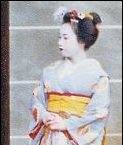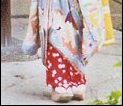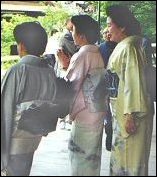
|
|
The
kimono
The Chinese influence was to be found in many aspects of life during
the Nara period (710-794). The long robes worn by Chinese nobles were
interpreted into what is now the kimono.
During the Heian period (794-1185), the kimono developed into a more
complex style with many layers of different colours and patterns.
A simple kimono was often given (instead of money) as a reward for
a service, a messenger carrying a most favourable message might receive
such a gift. |
 |
The most elaborate
kimonos are today worn by
apprentice geisha, called Maiko: |
 |
| From relatively simple
to amazingly elaborate, the kimono has an incredible variety of styles
to its name. There are styles of kimono for marital status, formal
and informal occasions, travelling, bridal kimonos and mourning kimonos. |
 |

|
Construction of the
kimono produces a perfectly flat garment that can be folded into a
convenient square shape for storage.
It can be taken apart and re-sewn for cleaning or a change of lining
colour.
Both colour and design are significant in how and when a kimono is
worn, each season had its own range of colour and pattern:
Cherry blossoms for spring time or the Fuji-Gasane (shades of wisteria)
kimono in lavender with a blue lining.
For summer, patterns of ocean waves or the Beni-Hitoe, a red unlined
kimono was worn. |
Today's kimono
for a day out |
Autumn patterns included
red maple leaves and for winter, plum blossoms, the Ume-Gasane, was
white with a red inner kimono. |
| Of the many specific kimono forms, here are just
a few: |
| Juni-hitoe |
'twelve layers' - A ladies ceremonial dress of
the Heian period.
Featured many layers of kimono in contrasting colours. |
| Kosode |
'small sleeve' - Kamakura
period. The usual large open sleeve was sown up, this style led to
the modern kimono. |
| Uchikake |
A full length outer robe worn
by women of noble rank during the Muromachi
period. By the late Edo period it was worn
by all regardless of class. |
| Furisode |
A long flowing sleeved kimono worn only by unmarried
women. The sleeves could be 'waved' to attract a would-be lover. Edo
period. |
Kuro (black)
Tomesode |
Worn by married women. Short sleeves with smaller
openings. The formal 'Five crested' version bore a kamon,
the family crest in white. |
| Iro Tomesode |
A light and colourful kimono for married women
on formal occasions. |
| Shiromuku |
A bridal kimono of pure white. |
| Homongi |
A formal kimono worn when visiting by married or
unmarried women. The sleeve length was longer for an unmarried woman. |
| Mofuku |
A kimono for mourning. Plain black silk bearing
kamon. |
Obi
A sash tied about the waist, this essential
element of the women's kimono developed during the Edo period into
forms with elaborate bows. At first it was tied at the front, then
later unmarried women began to tie it at the back. This gave rise
to hundreds of different styles of obi, all with different social
meanings. The 'sunrise drum bow' for formal occasions, the
'shellfish bow' for visiting or the 'arrow bow' for
every day use. The fashion and style of bow was also greatly influenced
by kabuki actors. |
 |
Obi makura |
A pad which gives shape to the bow. |
| Obi-jime |
The cord tied at the front of the obi. |
| Obi-dome |
A broach attached to the front of the
obi for decoration. |
Other Garments
Nobles and samurai also wore the kamishimo,
a sleeveless jacket with wide shoulders together with hakama,
(divided skirt) wide, loose trousers.
Samurai class women would often wear elaborate veils, for modesty,
when travelling. The Ichime-gasa was not
unlike a long curtain around a wide brimmed hat. |
| Haori |
A lightweight outer coat, usually of silk, often
black. Worn as ceremonial attire for men, also worn by women in the
late Edo period. Cords with tasselled ends
are tied in a specific fashion to fasten the coat. |
| Michiyuki |
Three-quarter length outer coat of crepe, satin
or spun silk. Patterns included stripes and checks. |
| Dochu-gi
|
An overcoat of three-quarter or half length made
from spun silk or wool. Worn for protection & warmth. |
| Hitatare |
Common wear for samurai during the Kamakura
period (1185-1333). The kimono had pull strings to close the wide
sleeves. |
| Yukata |
An unlined cotton kimono usually worn after taking
a bath. |
| Eboshi |
A cap worn by nobles in the Muromachi
period (1338-1568) |
| Footwear |
|
| Tabi |
White, split-toed socks of linen. |
| Zori |
Sandals, worn outdoors with tabi. |
| Geta |
Raised wooden sandals. Usually worn without tabi.
|
|


